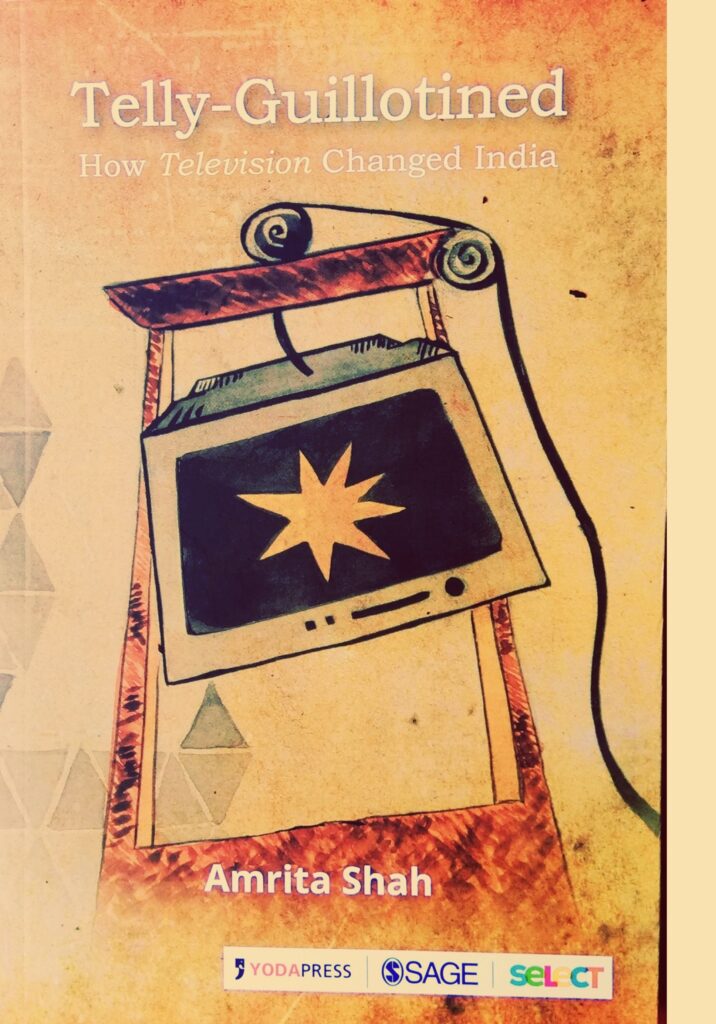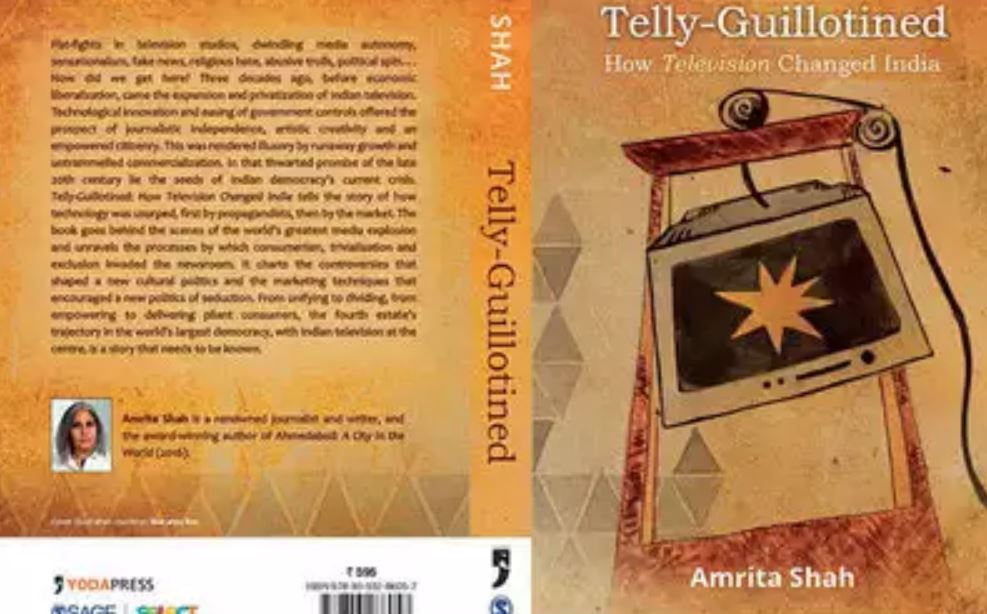Bhaskar Parichha

There couldn’t have better timing than this to read a book on the journey of India’s small screen. Only recently Doordarshan turned 60. Established on September 15, 1959, India’s first television service provider, Doordarshan began its services as “a modest experiment in public service telecasting”. The state-owned network continues to be a chip off the old block while our drawing rooms have been invaded by scores of belligerent networks.
Refurbished and with new insight, ‘Telly-Guillotined: How Television Changed India’ by Amrita Shah (SAGE) tells the story about the TV technology being grabbed – first by propagandists and then by the market. In the wake of the precedent and emerging scenes of the world’s greatest media explosion, this brilliant book describes the impact of consumerism on the newsroom. It goes farther to study the surfacing of a new ‘cultural politics’ and the rise of a new ‘politics of seduction.’
According to the author, three decades ago, before economic liberalization, came the expansion and privatization of Indian television. Technological innovation coupled with easing of government regulations brought in its fold ‘journalistic independence, artistic creativity and the empowered citizenry. But, as she exemplifies, this newly-acquired freedom was only short-staying. The whole milieu was ‘rendered illusory by runaway growth and untrammeled commercialization.’
She sees the present state of the country’s television being in a crisis mode and the promise of the late 20th century lay completely thwarted. The book paints a picture of the Fourth Estate’s challenging future in the context of ‘technological innovation, blurred boundaries, and sensory overload. ‘Her description of today’s television program in India is acerbic and irrational: ‘fist-fights in television studios, dwindling media autonomy, sensationalism, fake news, religious hate, abusive trolls, and political spin.’

The biographer of Vikram Sarabhai and author of the award-winning book ‘Ahmadabad: A City in the World’, Amrita Shah has been a journalist and a writer for several decades having worked for ‘Time’ magazine, edited features magazines ‘Debonair’ and ‘Elle’ besides contributing editor with ‘The Indian Express.’ An alumna of the Institute for Public Knowledge, New York University, she has been visiting faculty at the Centre for Contemporary Studies, Indian Institute of Science, Bengaluru.
Divided into more than a dozen, the chapters are somewhat evocative: How did we get here/The Big Leap/The Middle Class Strikes Back/The New Guerrillas/Star Trek/The Rath Yatra/Everything Must Go/Love for Sale/Let’s Play Life/The Backlash/Indians in Blue Jeans/The Age of Infotainment and Angry and Addicted. Between these chapters, she weaves the whole story of the television as it progressed in India.
‘Telly-guillotined’, as the title suggests, is a serious book on the small screen and goes beyond the rhetoric. Her approach, style and the profundity of the book are remarkable. From the point of view of sociology, politics, and television- journalism this is a captivating book and, therefore, its audience could be expansive.
Amrita delves into policy, the market place and the new-fangled ethos of the newsroom. There isn’t a single big event or episode that has escaped her gazing eyes: ‘In Indira Gandhi’s time, coverage of the prime minister was dull and predictable: usually silent footage of her visit to a city or a village with a monotonous voiceover. The only times she actually spoke on television was when she addressed the nation or when Doordarshan televised her speech at some gathering. Consequently, she never came across as a real flesh-and-blood person on TV.’
But she sees a big change when Rajiv Gandhi became Prime Minister: ‘Though the clever packaging and his own considerable charm made Doordarshan’s obsession with the prime minister more diverting than it had been in Indira’s days, it did not do much for the credibility of the medium. To counter the potential harm, cosmetic changes were made on television. A current news program went on air for the first time, and in ‘Janvani’, the public was actually allowed to confront cabinet ministers….By 1989, towards the end of Rajiv’s tenure, it was clear that the 21st century was still a distant dream. Poverty had not been eradicated. More than half the population could not read or write. Terrorism raged in Punjab and Assam. In Kashmir, conditions had worsened. The government’s clever tactics with regard to television no longer worked. The news continued to read like handouts, giving the lie to Rajiv’s purported desire for objectivity on television. And Doordarshan’s obsession with the prime minister had finally led to overkill.’
In the preface, she writes about the present-day scenario of the electronic medium rather scathingly: ‘Loud, Sensationalistic, Irresponsible, Trivial and Dangerous – these are some of the ways in which the Indian news media is perceived by many in the country today. Diminishing public respect has rendered journalists vulnerable to the pressure of various kinds. Journalists are sacked en masse, heads of media companies are raided for expressing anti-establishment views, and senior news staffers are fired for taking on powerful politicians and attacked for exposing corruption and wrongdoing.
Her lament extends to the public too: ‘Even among crowds, while covering news events, reporters and photographers are liable to be roughed up and assaulted by random members of the public.’ Even as telling the truth, she concludes that ‘protecting the media’s purpose to advance the human urge for truth and justice in the new ethos is a challenge for our times.’
For its insightful deepness and the range of concerns, ‘Telly-guillotined’ will go a long way in understanding the structural significance of the tube in India.
‘Telly-guillotined’
Amrita Shah
SAGE Publications India
BI-1/I, Mohan Cooperative Industrial area
Mathura Road
New Delhi 110044






















